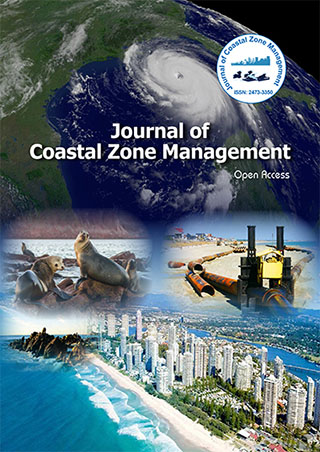Indexed In
- SafetyLit
- RefSeek
- Hamdard University
- EBSCO A-Z
- OCLC- WorldCat
- Publons
Useful Links
Share This Page
Journal Flyer

Open Access Journals
- Agri and Aquaculture
- Biochemistry
- Bioinformatics & Systems Biology
- Business & Management
- Chemistry
- Clinical Sciences
- Engineering
- Food & Nutrition
- General Science
- Genetics & Molecular Biology
- Immunology & Microbiology
- Medical Sciences
- Neuroscience & Psychology
- Nursing & Health Care
- Pharmaceutical Sciences
Commentary - (2024) Volume 27, Issue 5
Coastal Wetlands in Flood Mitigation and Protection: A Socio-Economic Perspective
Paolo Ricci*Received: 28-Aug-2024, Manuscript No. JCZM-24-26831; Editor assigned: 30-Aug-2024, Pre QC No. JCZM-24-26831 (PQ); Reviewed: 13-Sep-2024, QC No. JCZM-24-26831; Revised: 20-Sep-2024, Manuscript No. JCZM-24-26831 (R); Published: 27-Sep-2024, DOI: 10.35248/2473-3350.24.27.648
Description
Coastal wetlands, including mangroves, salt marshes and tidal flats, leads a significant role in flood mitigation and coastal protection. These ecosystems act as natural barriers, absorbing and dissipating the energy of waves, reducing the impact of storm surges and preventing coastal erosion. In addition to their environmental functions, coastal wetlands provide significant socio-economic benefits by protecting human settlements, infrastructure and livelihoods from the effects of floods and storms. This analysis explores the critical role of coastal wetlands in flood mitigation and coastal protection, highlighting the socio-economic implications of their conservation and management.
Flood mitigation and coastal protection
Coastal wetlands are highly effective in mitigating floods and protecting coastlines from the impacts of extreme weather events. Mangrove forests, for instance, have dense root systems that trap sediment and stabilize shorelines, reducing the risk of erosion. During storms, mangroves absorb wave energy, diminishing the force of storm surges before they reach inland areas. This natural buffer helps protect coastal communities from flooding, reducing the need for costly artificial defenses such as seawalls.
Salt marshes and tidal flats also lead a major role in flood mitigation. These ecosystems are characterized by their ability to absorb large amounts of water, acting like natural sponges that reduce the volume and velocity of floodwaters. By slowing down and storing floodwaters, salt marshes can mitigate the severity of flooding in adjacent areas, protecting homes, infrastructure and agricultural lands. This function is particularly important in lowlying coastal regions that are vulnerable to sea-level rise and increased storm intensity due to climate change.
Socio-economic benefits of coastal wetlands
The socio-economic benefits of coastal wetlands extend far beyond their role in flood mitigation and coastal protection. By reducing the risk of flooding and erosion, these ecosystems help protect human lives and prevent damage to property and infrastructure. This protection translates into significant economic savings by reducing the costs associated with flood damage, such as repair and reconstruction, emergency response and loss of income.
For example, a study by The Nature Conservancy found that mangroves provide flood protection benefits valued at over 65 billion annually, benefiting more than 15 million people globally. The economic value of these benefits is particularly high in densely populated coastal regions where the costs of flood damage can be enormous. In addition to direct cost savings, coastal wetlands contribute to economic stability by protecting critical infrastructure such as roads, ports and power plants, which are essential for the functioning of coastal economies.
Coastal wetlands also support livelihoods and local economies through the provision of ecosystem services. For example, many coastal communities depend on fishing, tourism and agriculture, all of which are supported by healthy wetland ecosystems. Mangroves and salt marshes provide nursery habitats for commercially important fish species, support recreational activities such as birdwatching and fishing and protect agricultural lands from saltwater intrusion. The economic value of these ecosystem services further underscores the importance of conserving and managing coastal wetlands.
Implications for conservation and management
The role of coastal wetlands in flood mitigation and coastal protection, their conservation and sustainable management are essential for ensuring the safety and well-being of coastal communities. However, these ecosystems are increasingly threatened by human activities, such as coastal development, pollution and land reclamation, which can degrade or destroy wetlands and diminish their ability to provide flood protection.
In conclusion, coastal wetlands lead a major role in flood mitigation anda coastal protection, providing significant socio-economic benefits by reducing the risk of flooding, protecting and sustainable management of these ecosystems are essential for protecting coastal communities from the increasing threats posed by climate change and human activities. By recognizing infrastructure and supporting livelihoods. The conservation and valuing the services provided by coastal wetlands, we can ensure their continued contribution to the resilience and prosperity of coastal regions.
Citation: Ricci P (2024). Coastal Wetlands in Flood Mitigation and Protection: A Socio-Economic Perspective. J Coast Zone Manag. 27:648.
Copyright: © 2024 Ricci P. This is an open-access article distributed under the terms of the Creative Commons Attribution License, which permits unrestricted use, distribution, and reproduction in any medium, provided the original author and source are credited.
